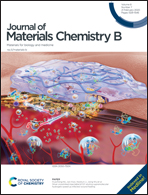Synthesis of spiropyran with methacrylate at the benzopyran moiety and control of the water repellency and cell adhesion of its polymer film†
Abstract
Stimuli-responsive materials have been actively researched over the past few decades. Among such materials, spiropyran is one of the most attractive compounds because the structure and polarity of the material are dramatically changed after photo irradiation, unlike other materials. In this work, we designed and synthesized a spiropyran derivative (SpMA) with a methacryloyl group on the nitrobenzene ring of a spiropyran skeleton. The UV spectra of the newly synthesized SpMA showed the photo-isomerization of spiropyran. The maximum absorption wavelength (λmax) of SpMA was 616 nm in n-hexane, a nonpolar solvent, although λmax of SpMA was 532 nm in methanol, a polar protic solvent, which resulted in an 84 nm blue-shift. SpMA was successfully polymerized by ruthenium (Ru)-catalyzed living radical polymerization. Poly(SpMA) (PSpMA) was then spin-coated on a PET substrate in order to control the surface properties of water repellency and cell adhesion. The water repellency was decreased approximately 10° under UV irradiation, because of the polarity change of PSpMA caused by photo-isomerization from the spiropyran (SP) type to the merocyanine (MC) type. In addition, NIH3T3 cells were spread only on 6% of the surface of the PSpMA thin film after UV irradiation compared with no UV irradiation. The polarity change of PSpMA by photo-isomerization is also believed to be the reason for this behavior. As a result, we successfully synthesized a photo-controllable cell culture scaffold.



 Please wait while we load your content...
Please wait while we load your content...